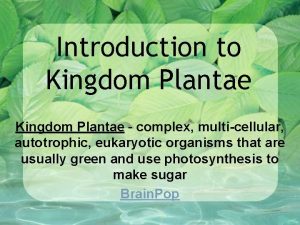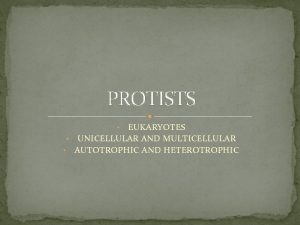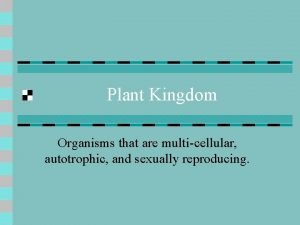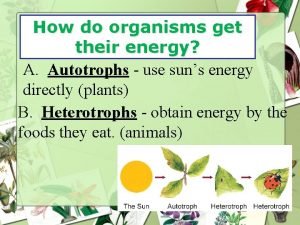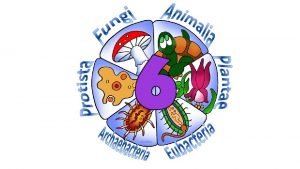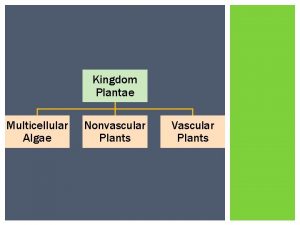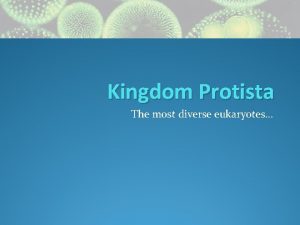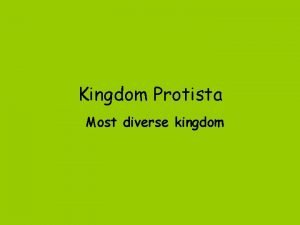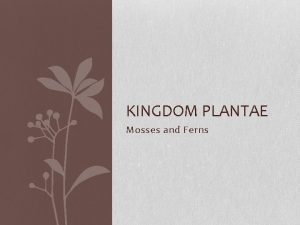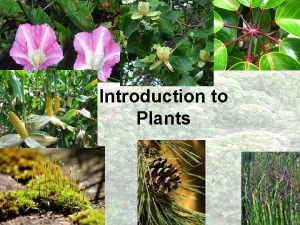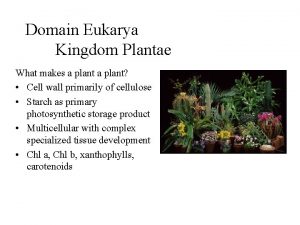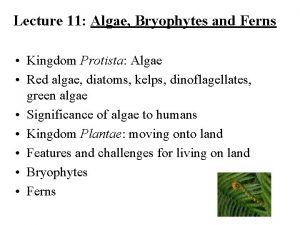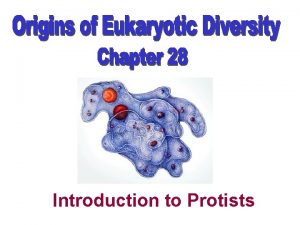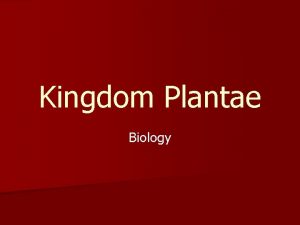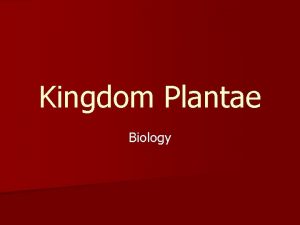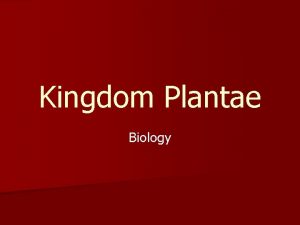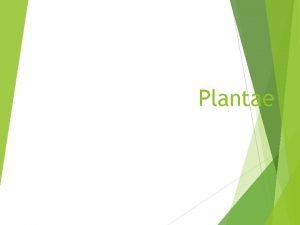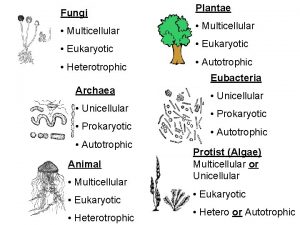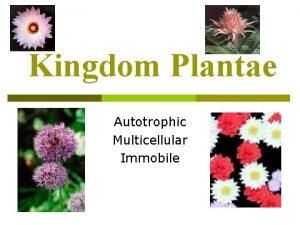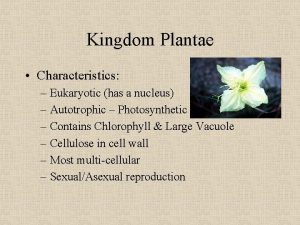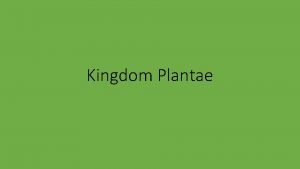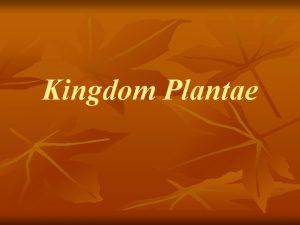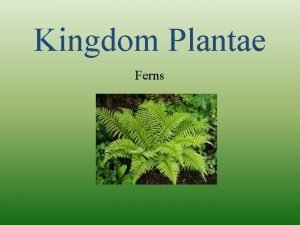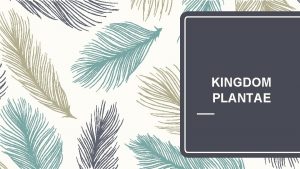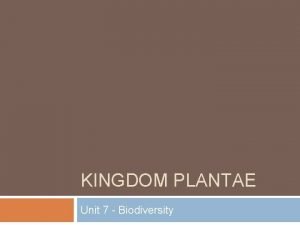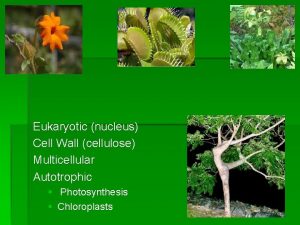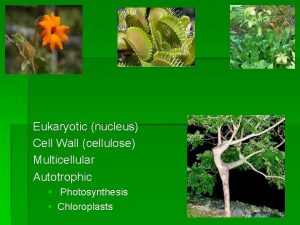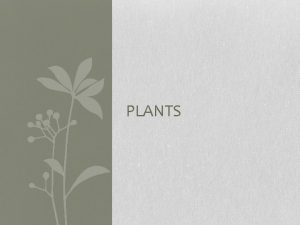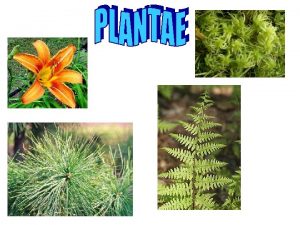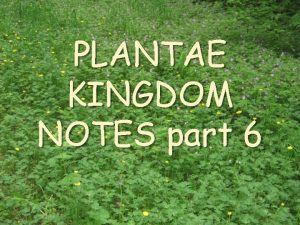Introduction to Kingdom Plantae complex multicellular autotrophic eukaryotic





























- Slides: 29

Introduction to Kingdom Plantae - complex, multi-cellular, autotrophic, eukaryotic organisms that are usually green and use photosynthesis to make sugar Brain. Pop

PLANT CHARACTERISTICS 1. Multicellular Organisms 2. Cells - Eukaryotic – Has a Nucleus - Surrounded by a Cell Wall 3. Producers (Autotrophic) - Make their own food through Photosynthesis


Origin of Plants • Similarities between modern green algae and plants suggest that both may have originated from an ancient species of green algae.

Photosynthesis Brain. Pop - Photosynthesis - the process by which a plant takes in carbon dioxide and water and in the presence of sunlight makes sugar and oxygen

Photosynthesis Carbon Dioxide + Water + Sunlight Sugars + Oxygen - Series of chemical reactions that use energy from the Sun to produce Sugars - Occurs in the Chloroplast -Chlorophyll - the green pigment IN chloroplasts where photosynthesis occurs - Photosynthesis is important because this is how plants make their food and get their energy

Plants also release energy through cellular respiration (mitochondria)

Plant Systems 1. Root System - Roots -Brings in water and nutrients 2. Shoot System – Stems and Leaves -Makes energy-rich materials -Moves material up and down through the plant *The Root and Shoot Systems are Organ Systems*

Nonvascular Plants • Have no “pipes” to transport water and nutrients. • They depend on diffusion and osmosis to move materials from one part of the plant to another. – Ex. Mosses and liverworts

Vascular Plants • Have tissues that deliver needed materials throughout a plant, much as pipes deliver water to faucets in your home. • Two groups – Plants that produce seeds – Plants that do not produce seeds • ferns, horsetails, and club mosses

Plants that produce seeds - 2 Groups Brain. Pop - Seed Plants Brain. Pop - Seedless Plants Gymnosperms Non-flowering plants Angiosperms Flowering plants

Groups of Living Plants Nonvascular Vascular No seeds Seeds Non-flowering Flowering

Reproduction Plants reproduce both asexually and sexually Brain. Pop - Pollination

Asexual Reproduction In asexual reproduction, there is only one parent and all offspring are identical to the parent

Sexual Reproduction -In sexual reproduction, there are two parents and the offspring inherit traits from each parent -Pollen carries the sperm in sexual reproduction

Plant life begins with a CELL:

A group of similar cells working together make a TISSUE:

A combination of two or more tissues that work together make an: ORGAN

A group of organs working together make an: ORGAN SYSTEM

Organ systems working together to create something that can live on its own is an: ORGANISM

Plants role in an Ecosystem Plants are producers – they are the first biotic factor in all land-based food chains sun plant worm turtle eagle (abiotic) (biotic) Brain. Pop

Review Questions True/False: Members of the Kingdom Plantae include: a. b. c. d. Ferns Flowers Trees Vegetables

In which kingdom(s) will you find complex autotrophic organisms? A. B. C. D. Kingdom Bacteria Kingdom Protista Kingdom Plantae Kingdom Animalia

What are the two products produced by plants during photosynthesis? a. b. c. d. sugar and carbon dioxide sugar and oxygen water and carbon dioxide water and oxygen

Which structure is found in a plant cell but not in an animal cell? a. nucleus b. cell membrane c. cell wall d. chromosomes

Which statement about photosynthesis and respiration is true? a. respiration stores energy and photosynthesis releases energy b. photosynthesis and respiration are the same process c. photosynthesis and respiration have nothing to do with energy d. photosynthesis stores energy and respiration releases energy

What two organelles in a plant cell are most closely related to the processes of photosynthesis and respiration? a. b. c. d. mitochondria and chloroplast lysosome and chloroplast mitochondria and vacuole ribosome and lysosome

Complex organisms, like plants, are organized in the following way: cells tissues organ systems organisms

Specialized cells that are similar in structure and function are usually joined together to form: a. b. c. d. Organs Tissues organ systems organisms
 Which kingdom is autotrophic
Which kingdom is autotrophic Plantae prokaryotic or eukaryotic
Plantae prokaryotic or eukaryotic Protista mobility
Protista mobility Plantae kingdom drawing
Plantae kingdom drawing Plantae domain
Plantae domain Unicellular and heterotrophic
Unicellular and heterotrophic A multicellular autotrophic organism with vascular tissue
A multicellular autotrophic organism with vascular tissue Plantae kingdom characteristics
Plantae kingdom characteristics Are mosses autotrophs
Are mosses autotrophs Introduction of kingdom plantae
Introduction of kingdom plantae Old kingdom middle kingdom new kingdom
Old kingdom middle kingdom new kingdom Old kingdom middle kingdom new kingdom
Old kingdom middle kingdom new kingdom Youtube egypt
Youtube egypt Capital of egypt during the old kingdom
Capital of egypt during the old kingdom Prokaryotic unicellular
Prokaryotic unicellular Plantae kingdom characteristics
Plantae kingdom characteristics Plantae multicellular
Plantae multicellular The most diverse eukaryotic kingdom is
The most diverse eukaryotic kingdom is Protista euglena
Protista euglena Biology taxonomy tree
Biology taxonomy tree Kingdom of mosses
Kingdom of mosses Main characteristics of plantae
Main characteristics of plantae Lycodiophyta
Lycodiophyta What domain is plantae in
What domain is plantae in Kingdom monera protista fungi plantae animalia
Kingdom monera protista fungi plantae animalia Eubacteria characteristics chart
Eubacteria characteristics chart Kingdom plantae
Kingdom plantae Plantae cladogram
Plantae cladogram Subkingdom of plantae
Subkingdom of plantae Endosymbiosis
Endosymbiosis
